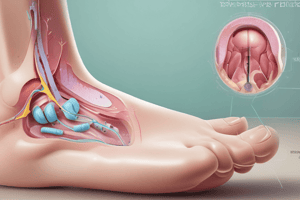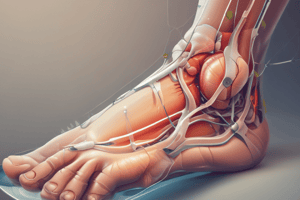Podcast
Questions and Answers
What is the primary purpose of a biomechanical assessment in podiatry?
What is the primary purpose of a biomechanical assessment in podiatry?
- To assess the range of motion in joints and identify any abnormalities (correct)
- To provide tailored exercises for strengthening and stretching
- To review pain and dysfunction and modify treatment if required
- To provide orthotic devices to assist with function and/or pain
What is the plane of motion in the foot that involves dorsiflexion and plantarflexion?
What is the plane of motion in the foot that involves dorsiflexion and plantarflexion?
- Transverse plane
- Frontal plane
- Sagittal plane (correct)
- Coronal plane
What is the purpose of range of motion (ROM) assessment in podiatry?
What is the purpose of range of motion (ROM) assessment in podiatry?
- To determine the entire amount of movement available in a joint (correct)
- To determine the strength of muscles in the foot
- To assess the flexibility of the foot
- To identify the source of pain in the foot
What is the term for the movement of the foot in which the sole of the foot moves towards the midline of the body?
What is the term for the movement of the foot in which the sole of the foot moves towards the midline of the body?
What type of assessment is used to observe the movement and function of the foot during activities such as walking and running?
What type of assessment is used to observe the movement and function of the foot during activities such as walking and running?
What is the purpose of providing tailored exercises in podiatry?
What is the purpose of providing tailored exercises in podiatry?
What is the primary focus of podiatrists in terms of biomechanics?
What is the primary focus of podiatrists in terms of biomechanics?
What is biomechanics, according to Joseph Hamill?
What is biomechanics, according to Joseph Hamill?
What is the purpose of range of motion assessment in podiatry?
What is the purpose of range of motion assessment in podiatry?
What is the term for a joint with lower ROM than the population norm?
What is the term for a joint with lower ROM than the population norm?
What is the relevance of range of motion assessment in biomechanics?
What is the relevance of range of motion assessment in biomechanics?
What is the consequence of restricted ROM in the foot?
What is the consequence of restricted ROM in the foot?
What is the relationship between biomechanics and the life sciences?
What is the relationship between biomechanics and the life sciences?
What is the function of ligaments in joints?
What is the function of ligaments in joints?
What is the primary goal of manual muscle testing in biomechanics?
What is the primary goal of manual muscle testing in biomechanics?
What is the definition of biomechanics according to Nick Stergiou?
What is the definition of biomechanics according to Nick Stergiou?
What is the term for a joint with higher ROM than the population norm?
What is the term for a joint with higher ROM than the population norm?
Why is it beneficial to have two feet when assessing ligament injuries?
Why is it beneficial to have two feet when assessing ligament injuries?
What is one potential consequence of muscle weakness?
What is one potential consequence of muscle weakness?
What is the purpose of manual muscle testing in podiatry?
What is the purpose of manual muscle testing in podiatry?
According to the Kendall grading system, what is the description of a score of 4?
According to the Kendall grading system, what is the description of a score of 4?
When performing manual muscle testing, how many times should the test be performed per muscle?
When performing manual muscle testing, how many times should the test be performed per muscle?
What is the direction of the resistance applied by the clinician during manual muscle testing?
What is the direction of the resistance applied by the clinician during manual muscle testing?
When testing muscles that cross two joints, where should the clinician start the test?
When testing muscles that cross two joints, where should the clinician start the test?
Which muscle is responsible for inverting the foot and dorsiflexing the ankle?
Which muscle is responsible for inverting the foot and dorsiflexing the ankle?
What is the action of the Gastrocnemius muscle?
What is the action of the Gastrocnemius muscle?
Which of the following bones is NOT mentioned in the lecture?
Which of the following bones is NOT mentioned in the lecture?
What is the primary objective of the lecture REHA1003 – Introduction to Podiatry?
What is the primary objective of the lecture REHA1003 – Introduction to Podiatry?
What is the action of the Soleus muscle?
What is the action of the Soleus muscle?
Flashcards are hidden until you start studying




